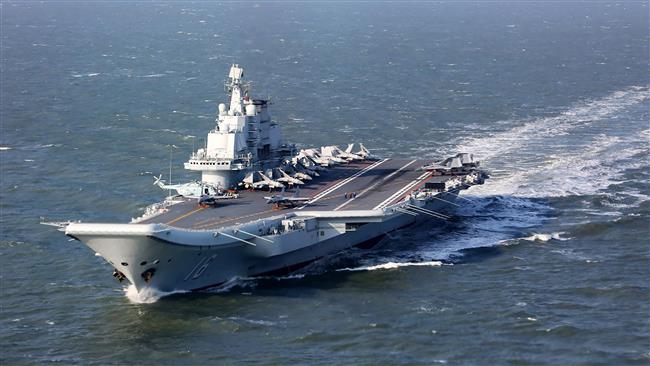China's first indigenous aircraft carrier 'taking shape'
China's second aircraft carrier is "taking shape" after two years and nine months of construction as the country is beefing up its military strength in the face of growing US military assertiveness in Asia.
A report on the state television and radio on Tuesday touched on the construction of The Shandong, China's first indigenous aircraft carrier, but did not give a date for its completion or further details.
China began building the aircraft carrier in its northeastern port of Dalian in 2014. The country's first aircraft carrier, The Liaoning, was bought from Ukraine in 1998 and rebuilt in China before being commissioned to People's Liberation Army Navy (PLAN).
The 60,000-ton Liaoning is capable of tearing through the waves at the top speed of 37 kilometers per hour and can embark 36 aircraft.
Last month, a Chinese naval battle group, involving The Liaoning, conducted a live-fire drill in northeastern waters in a show of force amid an escalating war of words with the United States.
The drills were held amid heightening tensions over Washington’s military presence in contested waters near China and a drama involving President Donald Trump’s controversial stance on Taiwan.
Washington has taken sides with China’s rivals in regional territorial disputes. Beijing says Washington is deliberately escalating the situation in the region and has denounced US patrols in contested waters as “illegal” and “provocative”.
Those tensions took a turn for the worse last month after Trump took a phone call from Taiwanese President Tsai Ing-wen, angering China which regards self-ruled Taiwan as part of its territory.
Trump later said he did not feel bound by decades of US diplomatic protocol recognizing such sovereignty unless China made certain economic and political concessions to Washington.
Chinese media warned the belligerent posture by the Trump administration could lead to a “devastating confrontation” between the two countries.
Since Trump’s phone conversation with Tsai, China has sent military aircraft close to the Japanese territory and a bomber to circumnavigate disputed territory in the resource-rich South China Sea.
Earlier this month, a group of Chinese warships led by The Liaoning tested weapons and equipment in the South China Sea in what the Chinese Foreign Ministry described as routine exercises.
The fleet was back from drills in the South China Sea, and its passage through the Taiwan Strait was also meant to signal that Beijing was serious when it came to matters of sovereignty.
China claims almost all of the strategic South China Sea, through which 6.5 trillion dollars in shipping trade passes annually. The sea is also claimed in part by Taiwan, Brunei, Vietnam, Malaysia, and the Philippines.

China hits back with 34% tariffs on US imports as fears of global recession rise

US will ensure ‘deterrence’ across Taiwan Strait: Pentagon chief

BRICS to establish 'digital' payment system: Russian minister
IRGC chief: Iran knows war formulas needed to defeat enemy
VIDEO | Ansarullah leader warns nations against supporting US aggression on Yemen
VIDEO | Conflict with Turkey in Syria...and Israeli divisions
Iran president sacks deputy for taking holidays to Antarctica
VIDEO | What is Na'amod?
Ukraine 'multiplying' energy attacks in Russia despite 30-day moratorium: Moscow
VIDEO | Mostafa, an architect turned filmmaker
Hamas, Palestine Red Crescent urge independent probe into Israel’s killing of aid workers












 This makes it easy to access the Press TV website
This makes it easy to access the Press TV website